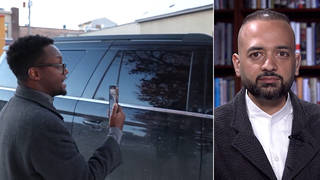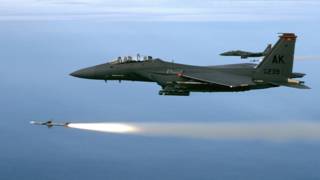
U.S. troops in Afghanistan are racing to evacuate people from the country ahead of Tuesday’s withdrawal deadline as the Kabul airport is targeted by rocket fire from militant groups. The rocket attacks come just days after over 175 people, including 13 U.S. troops, died after a suicide bomb outside the airport, with the group ISIS-K claiming responsibility for the attack. The Pentagon has publicly acknowledged that some of the people killed outside the airport on Thursday may have been shot dead by U.S. servicemembers in the panic after the suicide bombing. The U.S. retaliated over the weekend with two airstrikes the Pentagon says targeted more potential suicide bombers, but local residents say the strikes also killed Afghan civilians, including as many as six children. “We see how the war on terror in Afghanistan started and how it is ending now: It’s with drones and civilian casualties,” says Emran Feroz, an Austro-Afghan journalist and author. He says the U.S. airstrikes in the final days of the war — and the innocent people they killed — are emblematic of the entire 20-year conflict. “In many rural areas, these things happened on a daily basis,” says Feroz.
Transcript
AMY GOODMAN: This is Democracy Now!, democracynow.org, The War and Peace Report. I’m Amy Goodman, as we turn now to Afghanistan, where U.S. troops are continuing to leave ahead of Tuesday’s withdrawal deadline. Earlier today, the U.S. military intercepted five rockets aimed at the Kabul airport, where the U.S. has evacuated 117,000 people fleeing Taliban rule since August 14th. Today’s rocket attack came four days after over 175 people died, including 13 U.S. troops, after a suicide bomber detonated a large explosive outside the airport. The militant group ISIS-K claimed responsibility, the archenemy of the Taliban. The New York Times is reporting the Pentagon is now publicly acknowledging that some of the people killed outside the airport Thursday might have been shot dead by U.S. servicemembers after the suicide bombing. One BBC reporter wrote on Twitter, quote, “Significant numbers of those killed were shot dead by US forces in the panic after the blast.”
Over the weekend, the U.S. carried out two retaliatory strikes: first a drone strike in Nangarhar province on Friday and then another drone strike on Sunday in Kabul. The Pentagon said Sunday’s drone strike targeted a vehicle carrying as many as three suicide bombers. But local residents said the strike killed as many as 10 Afghans from the same family, including as many as seven children. Five of the kids killed were 5 years old or younger. The New York Times reports the dead also included a former Afghan army officer who had worked as a contractor for the U.S. military, who had came to Kabul with hopes of being evacuated.
Meanwhile, President Biden traveled to the Dover Air Base Sunday to pay respects to the 13 U.S. troops killed Thursday. The soldiers were all between the ages of 20 and 31 years old. They were all children, some just infants, when the U.S. invaded Afghanistan nearly 20 years ago.
To talk more about the crisis in Afghanistan, we’re joined by Emran Feroz. He’s an Austro-Afghan journalist and author. His book has just come out in Germany. It’s titled The Longest War: 20 Years of the War on Terror.
So, Emran, we spoke to you last week. Talk now about this eve of the final evacuation from the Kabul airport, named the Hamid Karzai International Airport, and all that has happened in these last few days.
EMRAN FEROZ: Yeah, thanks for having me.
So, first of all, as you already mentioned, Amy, we had two drone strikes which killed civilians in Afghanistan: one in Nangarhar province and the other one in Kabul. And I think this is very symbolic, because what we see at the moment is, you know, we see how the war on terror in Afghanistan started and how it is ending now: It’s with drones and civilian casualties.
And during the last days, after these attacks, we had a lot of officials say — journalism also, you know, many people in the media just parroting what Joe Biden and another officials said — that they were targeting terrorists and that this was retaliation and everything. But, basically, you know, I think it’s important to deconstruct a bit that, in fact, what happened now in Kabul with this drone strike happened all over the country many, many times in rural areas of Afghanistan, and often all these operations were based on flawed intelligence. And these officials, the responsible ones, they just try to sell us the good war, the good war on terror, which is using precise weapons that just kill terrorists.
And even in these final days, we see that this is not true and that civilians are the victims, while the main targets — for example, on October 7th, when the U.S. invasion of Afghanistan started in 2001, the very first drone strike had the intention to kill a Taliban leader and founder, Mullah Mohammad Omar, but Omar died more than a decade later naturally. Also, there is another guy who is running around alive and freely today in Kabul, Khalil Ur-Rahman Haqqani, a senior Taliban leader. And during the last years, we had so many reports that this guy was killed by a drone strike somewhere in a village or behind a mountain or whatever, but now he’s running around freely, still having his $5 million bounty on his head. And nobody asks the question: Who were the people who have been killed instead of him?
AMY GOODMAN: Emran, just before the show, you tweeted, “This is how thousands of Afghans lived under drones in rural areas for two decades.” I’m wondering if you can talk about that. And also, just to make clear, right now reporters on the ground, from the Los Angeles Times, Washington Post, New York Times, investigating whether it wasn’t collateral damage, the second car that was blown up with the family of 10, seven children — those numbers also have to be verified — but it was the wrong target that the U.S. hit. This is one of the things they’re investigating.
EMRAN FEROZ: Yes. So, the thing is, why we now have journalists investigating it is because Afghanistan is facing a lot of attention, one side, and on the other side, this drone strike happened in the capital of Afghanistan, in Kabul. So, of course, there are the journalists, fortunately, who could run to the site and investigate what happened.
But during the last two decades, and what I meant with this tweet was that, you know, in many rural areas, these things happened on a daily basis. And we had so many reports about, you know, dead terrorists killed by drone strikes and all these things, and just a few journalists visited these areas and actually witnessed what happened. I have been to some of these villages and rural areas during my last reporting trips within the last years, and often it was always the same story. People were just terrorized — you know, people like farmers and other laborers in rural areas were just terrorized by these drone attacks, while the targets — the Taliban, militants, and other ones — they had the ability to hide themselves. They were successful, because they knew, at the end, they will not be killed, but they will kill someone else, because often the intelligence was very flawed.
And we also have to remember a bit how often and how it happened and why it happened. In many cases, for example, we had security officials or American soldiers on the ground who just received wrong information because someone told him, “Hey, listen, this is a village. It’s full with Taliban,” but, actually, it was just a personal feud or something that was going on, and at the end, you had a lot of civilians being killed. There was also a lot of racism. You know, there’s also a lot of intra-Afghan racism between people from urban areas and rural areas, and also from different ethnicities, so at the end — or different tribes. So, at the end, all these things also played a role.
But the Americans, who had so many years over there, who stayed there for so many years, didn’t check anything, and they just used the flawed intelligence to bomb the people. And I think that something similar happened here. And at the same time, of course, we had all this retaliation rhetoric from Joe Biden. There was some kind of pressure, apparently, from the American public that something needs to be done, or maybe the U.S. administration felt that there is something we need to do now. And they also knew that, at the end, you know, they can say whatever they want. They drone some people. Nobody will check what happened, and people will just spread the official lie.
AMY GOODMAN: I wanted to read a quote from Mohammad Fawad. He is a relative of the family killed Sunday. He told the Los Angeles Times, “I want Joe Biden to know about this. Why do you attack these people and say it’s Daesh? … All of these kids were martyred. Look at them. Which one of these people is Daesh? These people worked with the government — with the U.S. And look at these kids. Do you think they’re Daesh?” And explain Daesh, another word for ISIS.
EMRAN FEROZ: Exactly. So, the thing is that also it’s not the first time, by the way, that allies of the Americans were killed. There were many drone strikes and night raids — I investigated some of them myself — where the victims were not just civilians, they were actually people who used to work with the Americans. And not a single one of these attacks, or most of them, wasn’t really investigated.
I think it’s really unrealistic that, you know, after such a short time after the airport attack, the Americans have the capabilities to find these Daesh members who were behind everything. The drone strike in Nangarhar also — which is a rural area, by the way. For this reason, we don’t know much about it at the moment like in the case of Kabul. But also over there, I think it’s rather unrealistic that the Americans could find the people who were behind the attack in such a short time span and bomb them.
But I think also that, you know, you will not — it will not be — the war on terror wasn’t successful. It was a failure because of all these things that happened, because of all the civilian casualties that happened, and that actually people like the Taliban could recruit successfully amongst the people who suffered from the war. And I think if this war will continue in such a way, we will still see militant groups, also people, of course, players on the ground like Daesh, you know, try and benefit from it.
AMY GOODMAN: I also wanted to raise The New York Times reporting the Pentagon is now publicly acknowledging that some of the people killed outside the airport on Thursday might have been shot dead by U.S. servicemembers after the suicide bombing. You know, we had the first reports that there was the suicide bombers. Then there were shooters. But we didn’t understand that possibly they were the U.S. soldiers shooting. And then you have the situation of the students and staff at American University in Afghanistan, New York Times reporting hundreds of them were turned away from the airport in Kabul on Sunday, reportedly among the most outspoken advocates for human rights. Taliban forces have reportedly sealed off Kabul’s airport to most Afghans who are hoping to evacuate. And this raised the issue of the U.S. working with the Taliban at this point to give people safe passage and giving all of their information, passport, etc., to the Taliban, but now they are turned back at home and afraid of being targets.
EMRAN FEROZ: Yes, that’s a total mess. There were recent news, you know, similar news, similar news on this here in Germany regarding people who used to work with NATO forces, with German forces. And I think this is from today, so it just came in. And there are also reports that, apparently, the German government handed over lists of these people to the Taliban. So, of course, what is going on here? All these people — I know a lot of people who are still in Kabul, not just people who used with NATO forces. You mentioned the students of the American University. I have relatives who went to this university. And they even didn’t try it, because they were like, “I don’t think that this will turn out in a positive way.” And actually, they were right.
So, a lot of people are still over there. It seems that a lot of Western governments think that, “Let’s be pragmatic and work with the Taliban now together.” I think it’s very dangerous to do it in such a way to hand them over all the lists of the people, because this really endangers them and, as we also know, a lot of them are still inside the country. Majority of them couldn’t leave. And I really fear, I’m worried about the future of these people, because it’s not clear what is going to happen to them. And I think it’s obvious that they will be persecuted by the Taliban. They will face violence. And at the end, I really wonder who will answer. But I think it might be similar to the U.S. —
AMY GOODMAN: Emran Feroz, we’re going to have to leave it there, but, of course, we’re going to come back to you, Austro-Afghan journalist. His new book, The Longest War: 20 Years of the War on Terror. I’m Amy Goodman. Stay safe. Wear a mask.












Media Options